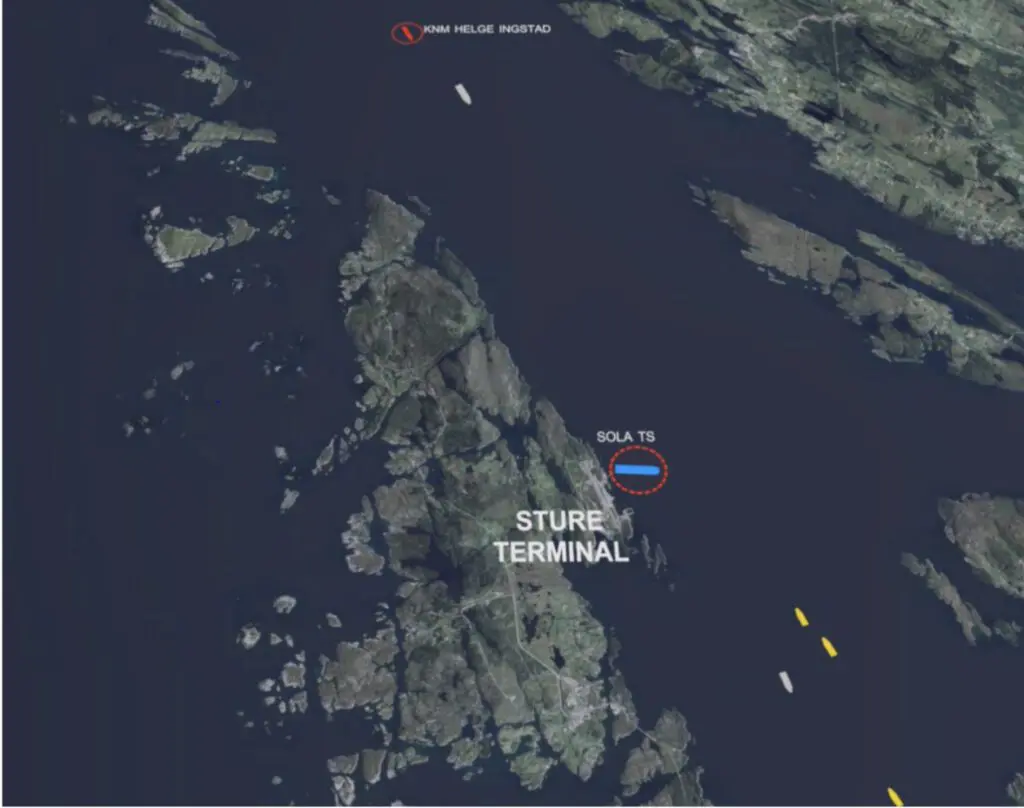The Weekly Reflektion 01/2023
Systemic failures in the Norwegian Navy, on the Sola TS and Fedje Vessel Traffic Service were causes of this collision.

Should we put the blame on human error or address the systemic failures?
This is the third Reflektion regarding the collision between the Sola TS oil tanker and the Norwegian Navy frigate Helge Ingstad. The first two were Reflektion week 51 where we gave an overview of the incident, and week 52 where we discussedthe situation from the point of view of the bridge of the Helge Ingstad. This Reflektion focuses on the roles played by the Sola TS and the Fedje Vessel Traffic Service (VTS).
At 02:50 on 8th November 2018, Helge Ingstad informed Fedje VTS that they were entering their area of responsibility. As there was little traffic Fedje VTS saw no reason to inform other vessels in the area or track the vessel with radar. The Helge Instead had its Automatic Information System (AIS) in passive mode meaning that it could not be automatically identified by other vessels.
At 03:13 there were three vessels travelling northward in addition to the Sola TS about to exit from the Sture terminal(see figure). At 03:36, the Sola TS was manoeuvring out from the terminal for a course northward while Helge Ingstad was approaching from the north. At 03:45 Sola TS informed Fedje VTS that they were leaving Sture, and Fedje VTS registered that traffic was getting heavier but took no further action. The Sola TS had its deck lights on as the crew were busy on deck. These deck lights were so bright that the navigation lights could not be seen from the Helge Ingstad bridge, where the crew had already identified the brightly lit vessel as stationary on or near the shore. Both OOWs on Helge Ingstad agreed at handover that it was a stationary object on or close to land. The handover took place shortly before the collision.
As the Sola TS travelled northward, it became concerned that an unidentified vessel was on a collision course and called Fedje VTS asking for more information about the vessel. This was three minutes before the collision. Fedje VTS claimed no knowledge of the vessel, but 1,5 minutes before the collision ‘remembered’ that the vessel was the Helge Ingstad. Fedje VTS then assumed that the vessels would sort out the situation among themselves.
Sola TS contacted the bridge of the Helge Ingstad telling them to change course but the Officer of the Watch (OOW) on Helge Ingstad thought he was talking to one of the three vessels travelling northward. The OOW still thought that the floodlit object that was the Sola TS was stationary and on or close to land and had no reason to correct this assumption. The erroneous situation awareness was unchanged. The vessels were now too close to avoid a collision.
There was a pilot onboard the Sola TS to exit the terminal, but the investigation report found that the bridge team and the pilot were not working effectively together. Since there good visibility they were not tracking vessels on the radar. Communication between the pilot and Fedje VTS was in Norwegian with an English summary being given by the pilot. The vessel navigation manual stipulates that English should always be established as the common communication language between the pilot and the bridge team. This lack of radar plotting and communication in Norwegian was identified as a contributory factor in the bridge crew playing a less active role than they should have.
The Sola TS was also criticised because of the bright deck lights making their navigation lights almost invisible. The regulations for the prevention of collision at sea state that between sunset and sunrise lights (including deck lights)should not impair the visibility and distinctive character of the navigation lights. These lights could have warned the crew of the Helge Ingstad that a vessel was approaching.
Fedje VTS was criticised for poor monitoring of marine traffic, and of giving inadequate information concerning vessel movements to marine traffic in the area. Technology advances in automatic identification of vessels and radar systems are of course an important aspect in prevention of collisions at sea. Hopefully these will not lead to complacency among the people monitoring vessel movements.
All three participants in this collision, the Norwegian Navy, the Sola TS and the Fedje VTC made failures that were compounded by failures by the other participants. . When many participants are interacting, they should continually consider how they can make the others good and ensure that ongoing errors be corrected as quickly as possible. As we noted in the previous Reflektions human performance is variable and not as consistent as we like to believe.
The officer on the watch (OOW) on the Helge Ingstad will be prosecuted for his role in the collision. In our three Reflektions we have discussed many failings and systemic errors that contributed to the collision, and we believe placing the blame on a single person is unreasonable. Was the officer of the watch guilty of negligence or gross negligence? Would another person with the same experience and competence in similar circumstances have handled the situation differently and avoided a collision? As with most hypothetical question there is a perhaps and perhaps not side. Resorting to the playing the ‘human error’ card and selecting one person to prosecute is not in itself likely to lead to the changes that are required to prevent future incidents. Making an example of a relatively inexperienced officer is not going to make his colleagues and contemporaries more competent and experienced and solve the other systemic errors related to the collision.
